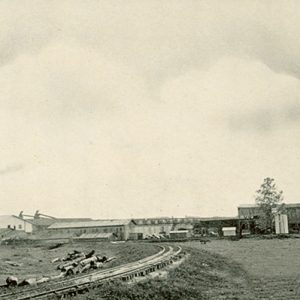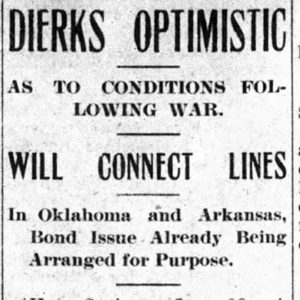calsfoundation@cals.org
Herman Dierks (1863–1946)
Herman Dierks was the co-founder and two-time president of the Dierks Lumber and Coal Company, supervising its lumberyard in De Queen (Sevier County) and other parts of eastern Oklahoma and northern Louisiana. With the help of his brothers, he helped create and control the Dierks timber empire.
Born near Lyons, Iowa, on September 24, 1863, Herman Dierks was the seventh child of Peter Henry Dierks, a German farmer and a banker, and Margaretha Dorothea Tauk, a Danish immigrant. He joined his brother Hans in Nebraska after Hans bought land there along the newly constructed Burlington Railroad. Dierks farmed until he and his brother bought a lumberyard in 1887, which later proved to be the source of Dierks’s fortune.
On May 5, 1887, Dierks married Martha Anne Waters; they had several children. The couple divorced in 1919, and he later married Julia Campbell Smith.
By 1893, once the brothers owned a dozen lumberyards in Nebraska, Dierks tried to set up a new operation farther south, in Oklahoma. It never got off the ground, and he went back to Nebraska, where he, Hans, and their two other brothers, Peter and Henry, formed a partnership and named it Dierks Lumber and Coal Company. Herman Dierks initially served as secretary. In 1897, the Dierks brothers bought a sawmill and began to process the lumber they were harvesting. Following this, they purchased a large lumberyard in De Queen, which was a convenient location because of its proximity to the Kansas City Southern Railroad. By 1900, the company had twenty-four lumberyards, and its headquarters had been moved to Kansas City, Missouri.
In order to control operations at the De Queen lumberyard, Dierks moved to De Queen, although operations had to expand east into Indian Territory (present-day Oklahoma) and south in Louisiana to gain access to more timberland. He also served as president of the Florien Lumber Company, in Florien, Louisiana, which had originally been the Ayers Lumber Company until the brothers bought it in 1906. Business was very good and even provided lumber to Europe until World War I. Within thirty years, Dierks Lumber and Coal, as well as its sister operations in Oklahoma and Florida, purchased more than 1.2 millions acres of timber to become the biggest producer in pine lumber in the South.
As control of the company was passed on to the next generation, Dierks was not as active in the business as he had been, but when his brother Hans died, he took over as president and remained at the post until his death in 1946. During the 1920s, Dierks worked with the U.S. Department of Agriculture’s Forest Service to educate consumers about the conservation of forests. Though the company fell into receivership during the Great Depression, it was out of debt by 1938.
In 1969, twenty-three years after Dierks’s death on April 3, 1946, the company sold all its assets to Weyerhaeuser Company. Until that time, it had been the largest family-owned landholding in the history of the country. Dierks is buried in Forest Hill Cemetery in Kansas City, Missouri.
For additional information:
Dierks, Francis McDonnell, Jr. The Legacy of Peter Henry Dierks, 1824–1972. Tacoma, WA: Mercury Press, 1972.
Smith, Kenneth L. Sawmill: The Story of Cutting the Last Great Virgin Forest East of the Rockies. Fayetteville: University of Arkansas Press, 1986.
Williams, Nancy A., ed. Arkansas Biography: A Collection of Notable Lives. Fayetteville: University of Arkansas Press, 2000.
Bernard Reed
Little Rock, Arkansas
 Business, Commerce, and Industry
Business, Commerce, and Industry Early Twentieth Century, 1901 through 1940
Early Twentieth Century, 1901 through 1940 Dierks Lumber Mill
Dierks Lumber Mill  Railroad Development
Railroad Development 




Comments
No comments on this entry yet.